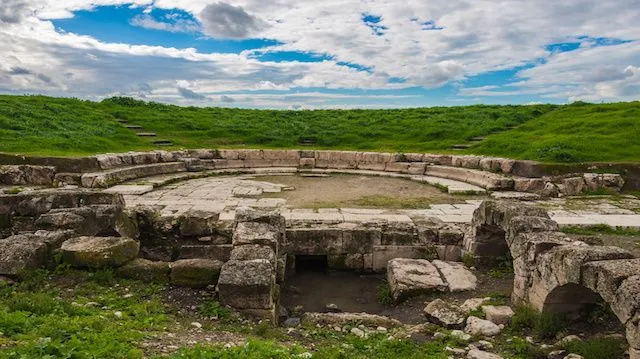
- Share on Facebook28
- Share on Pinterest
- Share on Twitter
If the mention of space archeology sends your overactive imagination into nebulous scenarios where humanity locates signs of alien life on distant planets then I must apologize. We’re not there yet. Space archeology has, however, created a golden age of discovery right here on Earth, and you can help expedite the process.
Space archeologists use cutting-edge, space-based technology to identify lost historical settlements by looking downward onto our own blue planet to spot things ordinary archaeologists on foot have missed. The latest discovery was a stone hearth that may indicate the founding of a lost Viking settlement. It was discovered hundreds of miles away from the only known Viking settlement in the New World. Such a discovery may serve to bolster the current belief that Vikings settled in the Americas only briefly. Alternatively,a hearth means a house, which could blow the short term theory out of the water.
Archaeologist and Egyptologist Sarah Parcak has helped to put space archeology on the map, so to speak, by winning the $1 million TED prize in 2016.
The TED prize is meant to help people change the world, and Parcak intends to do just that. By her estimation only a tiny fraction of historical sites have been discovered. Advances in technology have only recently made space archeology possible. With this new opportunity comes a new need — more space archeologists.
Right now we have a lot of pictures and very few human eyes. Computer eyes can cover the gap in some cases, but not all. Parcak’s plan is to create a science game called GlobalXplorer that delivers satellite images to regular people and allows them to search for settlements using basic guidelines in a game format. She intends to use Internet gaming to turn you and everyone into a space archaeologist.
Players are dealt a card that displays a potential archeological site. They are then led through a series of questions to help them to determine the likelihood of the site containing something interesting. If enough people see similarly promising characteristics, trained archeologists will know to prioritize that piece of land. Though the game will not reveal the location of sites reviewed by citizen scientists, if one is excavated archeologists then include the people who reviewed it through social media channels.
This isn’t the first time scientists have tried to hasten breakthroughs through crowd sourcing. Gamifying science has been wildly successful in the past.
The most successful example of scientific discovery through crowdsourcing was taking a complex problem and delivering it to the masses in the form of a game called Foldit. This online puzzle had users compete to figure out which proteins best fit into scientists’ research criteria. The collective effort of the crowd solved in 10 days what scientists had been struggling to complete over 15 years. They found the structure of the aids-causing Mason-Pfizer monkey virus.
Other gamification projects have helped advance science. GalaxyZoo enlists crowds online to aid in identifying galaxies and Eyewire has more than 200,000 regular people helping to map the 3D structure of neurons in the brain.
Parcak is hoping that bringing the crowd to archeology will be similarly successful. She even has thoughts on how space archeology can complement space exploration, although with this caveat: “I would argue that, with all this obsession we have with going to outer space — a colony on Mars! — we should stop for a second, take a deep breath, and think about all the times we’ve tried to colonize places throughout history and how that’s never gone well.”
Luckily for space enthusiasts everywhere, Parcak isn’t the only archeologist to collaborate with NASA. Many archeologists have collaborated with the space agency. NASA even has published a book on how archeologists have aided the search for civilizations entitled Archeology, Anthropology and Interstellar Communication. So while Parcak may be studying images of Earth collected from space, the study of images of space collected from space isn’t science fiction, either.
—Erin Wildermuth
Erin is a freelance writer, photographer and filmmaker. She is passionate about moving beyond party politics to identify pragmatic solutions to social, economic and political problems. Her writing has appeared in the Washington Times, the American Spectator, Doublethink and Scuba Diver Magazine. She spends her free time scuba diving, snowboarding and ravenously reading popular nonfiction. Erin holds a master’s degree in International Political Economy from the London School of Economics.
Sources:
http://news.nationalgeographic.com/2016/03/160331-viking-discovery-north-america-canada-archaeology/?utm_medium=email&utm_source=digg
http://www.npr.org/sections/alltechconsidered/2016/02/17/467104127/space-archaeologist-wants-your-help-to-find-ancient-sites
http://www.globalxplorer.org/about/#bio
http://www.wired.com/2016/02/sarah-parcak
http://yukaichou.com/gamification-examples/top-10-gamification-examples-human-race/#.VwvsvPkrLIU
https://www.galaxyzoo.org
http://blog.eyewire.org/about
http://eyewire.org/explore
http://www.anthropology-news.org/index.php/2016/01/31/archaeology-and-nasa
https://www.nasa.gov/sites/default/files/files/Archaeology_Anthropology_and_Interstellar_Communication_TAGGED.pdf
- Share on Facebook28
- Share on Pinterest
- Share on Twitter

